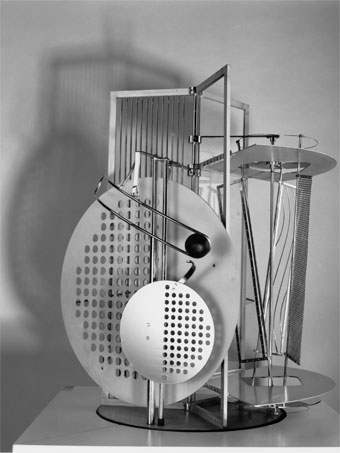
Laszlo Moholy-Nagy, Licht Raum Modulator, 1970 reconstruction, image: bauhaus.de
Did I say a few minutes?
Laszlo Moholy-Nagy spent around eight years [from 1922-30] building his Light Space Modulator, and then he carted it around Europe, and to America, reworking it and repairing it until his death in 1946. His widow Sybil donated it to the Busch-Reisinger Museum at Harvard in 1956.
Anyway, while the kinetic and light art movements it prefigured were kicking into high gear, the original LSM was in quite a state of disrepair. It sounds far, far away from Moholy Nagy’s own early description of it, which included not only the motorized glass, cellophane, aluminum, and steel construction we know, but a stage-like box lined with synchronized, colored lights. [I was going to quote some of the description from Medienkunstnetz, but it doesn’t clear anything up; just read the whole thing.]
Yet Moholy-Nagy’s posthumous influence was growing, and the LSM was exhibited widely throughout the 1960s in its second[ary] mode as a room-filling projection. After some malfunctions and damage during a big KunstLichtKunst exhibition at the VanAbbemuseum in Eindhoven, though, something had to be done.
In 1969-70, the Harvard art historian-in-training Nan Piene was studying Moholy-Nagy’s work and wanted to include the Light Space Modulator in an exhibition at Howard Wise Gallery in New York. [Nan’s then-husband, Otto Piene, also showed kinetic and light works at Howard Wise. He was a fellow at MIT’s Center for Advanced Visual Studies, which he took over in 1974.]
So with Mrs. Moholy-Nagy’s permission, Mrs. Piene had the LSM refabricated. Twice. One copy went on view at Howard Wise in 1970. One went to the Venice Biennale. One was flagged for the Bauhaus Archiv in Darmstadt, and the other ended up back at the Van Abbemuseum.
In his NYT review of the show, Hilton Kramer wrote at length about the implications of this “entirely new kind of art object–costly and painstakingly made facsimile reproductions of certain classic works of modern art.” Moholy-Nagy’s intent, according to Piene according to Kramer, was the Constructivist fusion of object and space, light and motion, perception and experience. But.
As usual with Moholy, what we have here is not a completely successful work of art but a brilliant statement about a new possibility for art. In an age of conceptual art, when ideas need only be stated to be taken for realizations, the distinction I am making may seem a little archaic. But for those of us who remain firm in our belief that what is important in art is not what the artist says he is doing or intends to do or is said to have done, but what he actually achieves in the work itself, the distinction is crucial.
Just as I didn’t research the Eames Solar Do-Nothing Machine with the intention of tracking the history of Moholy-Nagy, I didn’t dig into the refabrication of the LSM with the intention of agreeing with Hilton Kramer about conceptual art. But here we are. With his Telephone Pictures, Moholy-Nagy was famously ahead of the curve on outsourced production, so it might be natural to see his work as fitting easily with the era’s emerging conceptualist norms.
Here’s a video of the Eindhoven Light Space Modulator in action:
I have to say, it’s fantastical and beautiful, but it’s also precious and underwhelming. Like Kramer, I am glad it exists, but I don’t quite know what to think of it. Maybe that it works best as film and photo, i.e., as a prop, shot, cropped and edited by Moholy-Nagy’s own eye.
In 2006, Tate Modern and the Busch Reisinger arranged with the Moholy-Nagy estate, now controlled by the artist’s daughter Hattula, to make yet another, yet more definitive replica of the Light Space Modulator, which by now is going by an earlier, more correct title, Light Prop for an Electric Stage. After the Tate showed it, Peter Nesbit, the [Daimler Benz] Curator at the Busch-Reisinger showed their new, functioning replica alongside the static original in Light Display Machines: Two Works by Laszlo Moholy-Nagy.” Except that one condition of the replica authorization agreement was that the 2006 version, at least, “not be considered a work of art.”
That is the word according to a paper/discussion presented at Tate in October 2007 by Henry Lie, the director of the Harvard Art Museums’ Straus Center for Conservation Studies. [Lie discussed the details of the history of the LSM LPfaES at a workshop titled, “Inherent Vice: The Replica and its Implications in Modern Sculpture,” which is just about the most awesome collection of art reading material this side of the Packing, Art Handling & Crating Information Network.]
The 2006 replica was made by a German engineer named Juergen Steger, and Lie’s presentation goes into exquisite detail on his build. Steger referenced not only the original and all the photo and film evidence, but also the 1970 replicas, which were built, I should have mentioned, by Woodie Flowers, an MIT graduate student who went on to become a rather legendary robotics professor at the school.
When I first stumbled across this whole Light Space Modulator replication business a couple of months ago, I decided to email Prof. Flowers to see what was up. He called me right back, and we had a quick, intense, funny, and fascinating chat about the project, how he got involved, and how it went down. I will go into more details of Woodie’s account in…in a few minutes.
